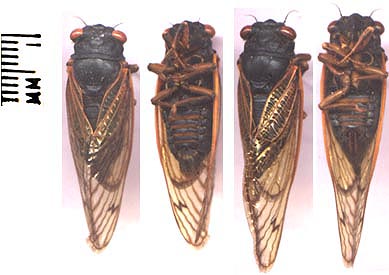Little 13-year cicada

Usually smaller than M. tredecim and similar to M. tredecassini in size, with narrow, well-defined orange stripes on the underside of the abdomen but no orange coloration in front of the wing insertion behind the eye. This species may be less abundant or more patchy than M. tredecim and M. tredecassini. The calling song of the -decula sibling species is rhythmically unlike those of the other two forms, and consists of a series of short phrases lasting 15-30 seconds. The first two courtship songs have not been well characterized, but may bear the same relationship to each other as the courtship songs of the other species. Scale is 1 cm long.
You can rotate the 3-D models of M. tredecula below to see them from all angles.
General information about the signals of this species is included here.
Magicicada tredecula songs:
Magicicada tredecula songs are extremely similar to those of M. septendecula
Courtship/ Calling song
Approximate range
In the map below, cicada symbols are verified records in our database as of August 2023. This map may not be reproduced without written permission.
Literature
Alexander, R. D., and T. E. Moore. 1962. The evolutionary relationships of 17-year and 13-year cicadas, and three new species. (Homoptera: Cicadidae, Magicicada). University of Michigan Museum of Zoology Miscellaneous Publication 121:1-59.
Marlatt, C. L. 1923. The Periodical Cicada. United States Department of Agriculture, Bureau of Entomology Bulletin 71:1-183.